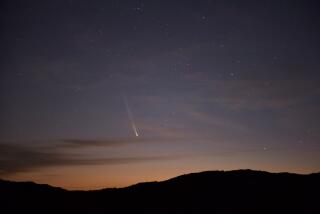All Aboard Halley’s Time Machine
- Share via
I recently received a note from a Mrs. Sanford, an elderly woman in the Midwest, addressed to “Astronomer Yeomans.” She relayed her recollections of Halley’s comet in 1910 and expressed surprise that she would live to see the great spectacle a second time. Her father had held her in his arms as they both admired the comet’s subtle beauty stretched across the western sky. She said that the sight of the comet with her father that night in May was one of her most cherished memories. A postscript added that she had just turned 85 and that she hoped the comet was in better shape than she was.
Halley’s comet is indeed in good shape, although the reception we are preparing for it is difficult to justify on scientific terms alone.
Like many of my astronomer colleagues, I’ve been trying to explain that comets in general, and Halley’s comet in particular, represent the least changed material in our solar system and, therefore, it offers our best opportunity for examining the chemical mixture from which our solar system formed 4.5 billion years ago.
Halley’s comet is described as a dirty snowball three miles in diameter with an enormous surrounding atmosphere, and it is thought that this snowball contains the same primordial mix from which our solar system formed.
The return of Halley’s comet is indeed an extraordinary opportunity for answering some of the basic questions on our origins.
But can we really explain, on scientific grounds alone, the fleet of five international spacecraft designed to study the comet from within the comet itself? Can we explain the activities of thousands of professional and amateur astronomers and literally millions of others who will turn their eyes heavenward for a glimpse of this hurtling emissary from the interplanetary void? Should the arrival of a ball of ice warrant more than two dozen shipboard cruises to view the comet from the Southern Hemisphere and the production of more than three dozen different Halley’s comet T-shirts? I think not.
This comet’s fame is not due to its scientific importance alone. Its return to the Earth’s neighborhood, every 76 years or so, acts as a clock counting time in units of a human lifetime, reminding us of the beauty and harmony of the universe and the daunting insignificance of our own place in space and time.
It is a display of permanence in an uncertain world, marking transitions from one era to the next. Our parents and grandparents have told us of this great comet’s return in 1910, and we will tell our own progeny about its return in 1986. Once during their lifetime, nearly all people have the opportunity to view the comet for themselves.
It takes just 29 lifetimes to return to early June in 240 BC when a comet as bright as the brightest stars appeared--the first recorded sighting of Halley’s comet (as it was named, in 1758, for astronomer Edmund Halley, who’d discovered the comet’s 76-year-cycle in 1682.) The great comet was noted in 12 BC during the funeral celebration of Marcus Agrippa, the Roman general who defeated the forces of Marc Antony and Cleopatra. When it returned in 66 AD, the comet was thought to presage the destruction of Jerusalem by the Romans. A thousand years later, it was taken as a malefic sign by Saxon armies, who were soon afterward defeated in the Battle of Hastings--the first and most decisive battle in the Norman conquest of England.
The comet has been recorded at each of its returns since 240 BC, and invariably, contemporary historians wrote about it in context of the ensuing disasters that were thought to be the result of the comet’s appearance.
When it returned in 1910, the tail of the comet swept the Earth. There are contemporary accounts of the great concern over whether poisonous gases in the tail would snuff out life on Earth. Mrs. Sanford can assure you that the comet’s return was a friendly visit. She also could tell you that television and other forms of visual assault have probably numbed our senses to so subtle a phenomena as Halley’s comet.
Visual spectaculars are of this age only. Halley’s comet is for the ages.
Viewers expecting the comet to light up the skies will learn otherwise and quickly return to their TV sets for amusement. Those with a strong sense of history, and of the continuity between one era and the next, will join Mrs. Sanford in seeking out the subtle, ethereal beauty of the comet from darkened country skies.
Show your children the great hurtling emissary from space and time, show them a witness to the funeral of Agrippa, the fall of Jerusalem, the Battle of Hastings. Introduce them to this seasoned traveler, an object of myths and fears, a bit of history, and an old friend. It may be one of their most cherished memories when the great comet returns in the summer of 2061.






